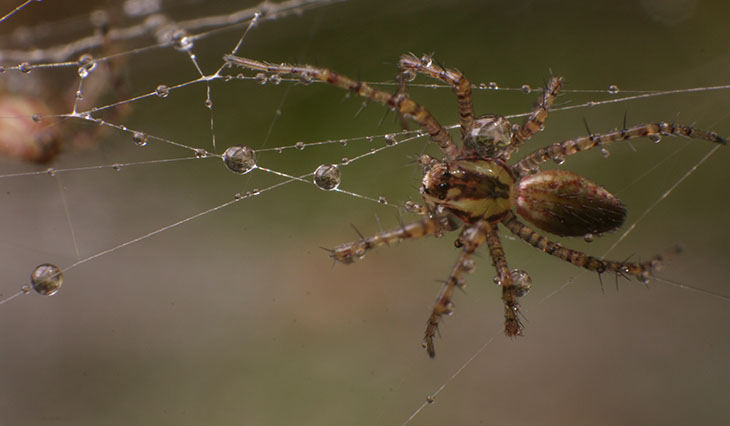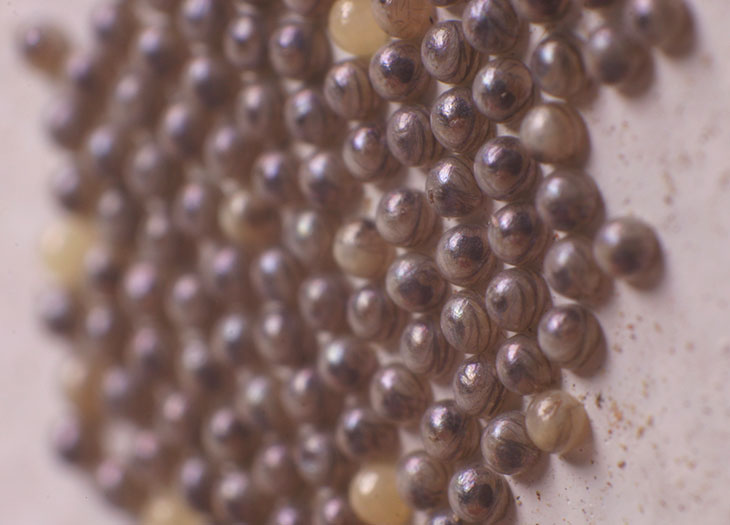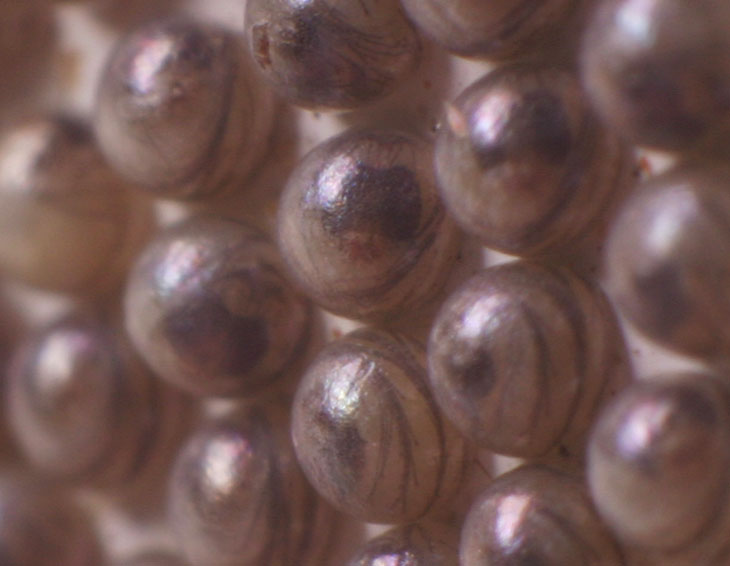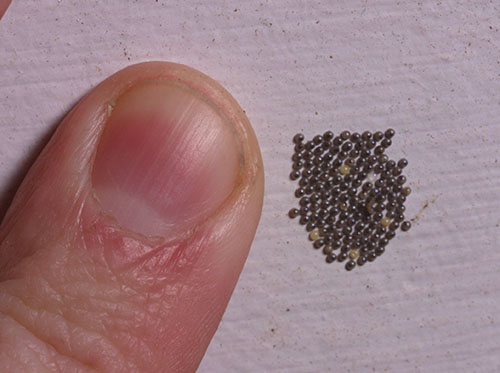
I know, I know, that’s not a caterpillar. Earlier today Yesterday [I have to stop doing these so late at night, or start ignoring the midnight change] I had checked on the green lynx spider young’uns, which are surprisingly still around, kinda. The ones on the dog fennel have largely dispersed, as have most of the orphans on the rosemary. But there remains a close-knit family on the butterfly bush, still sheltered under the wing (okay, bad metaphor) of the mother, who’s looking pretty emaciated right now. They’re certainly considering leaving home – right as I focused on one, it abruptly vanished from the viewfinder, having successfully cast a line into the wind and ballooned off. Unfortunately, like a few weeks back, it successfully transported itself all the way to my right sleeve, effectively negating any pics and sending it into panic mode since the terrain spelled ‘inhospitable’ to its little brain. I gathered it up and redeposited it back with the others, which possibly created a confusing cause-and-effect pattern to form, if spider minds even work in that way. But while doing some shots, I misted the web to make it stand out better for some experiments, sending a great number of spiderlings, and momma herself, into a frenzy – not of fear or the desire for shelter, as you might expect, but to collect the drops before they evaporated, since there’s been too many dry days recently.
But all that’s not getting us any closer to the title. On returning from that intrepid excursion six meters out the front door, I spied a curious patch on the wall under the porch light, recognizing them for tiny eggs.

These are a measured 0.6mm across, and the entire patch can be hidden under the tip of your little finger. Like most insect eggs and many chrysalises, the shells are clear, and the coloration is all coming from the occupants. The few pale ones that can be seen are eggs that failed to develop, while the darker ones are the soon-to-emerge… somethings. At higher resolution, the details are a little curious:

I figured the dark spots were heads, and certainly seemed like caterpillar to me, but the stripes or hairs seemed off, because I didn’t think any caterpillars were born with them. But on stepping out tonight for other reasons, I spotted the first emergent, who confirmed that I was wrong (as had a friend of mine):

Yep, that’s quite a ‘do it’s sporting, as it poses near its recently-vacated microcondo (with rotten privacy.) Moreover, you can see the breaches in several other eggs indicating that siblings are soon to follow. Last one, or few in this case, out really are rotten eggs…
I can’t help but think this is lousy timing, since most vegetation is going into dormancy for the winter and we’ve already had several frosts, stomping with finality on the desperate attempts of the basil and morning glories to keep going. It was pretty chilly as I got the shots of the newborn, and despite the lovely weather today we’ve got a chance of snow tomorrow. While those are some impressive follicles on my caterpillar friend, I’m suspicious of their ability to serve as a winter coat effectively.
 Yet, nature has a pretty good grasp on things, and the mother who deposited these eggs was following a behavioral plan dictated by thousands of years of selection – unless, of course, something went wrong. Of 138 eggs (yes I counted them, but in the image where I could Photoshop a colored dot to hold my place,) four are visibly non-viable, and who knows how many more genetic defects might be present, or were present in the previous generation? It remains possible that the mother who laid these was a bit funny in the head. However, I’m betting that this is business as usual and these little wrigglies are well-equipped to deal with the conditions. The newborn is visible in this pic too, just right of center, so as you can imagine from that, following their progress once they leave the distinctive surrounds of the egg cluster would be next to impossible. While I might find larger caterpillars later on, there would be little chance of determining if they were these hatchlings or not, and even keeping a few in a terrarium would require finding the right food for them, which would be only a wild guess on my part. I’ll assume nature’s got a handle on it.
Yet, nature has a pretty good grasp on things, and the mother who deposited these eggs was following a behavioral plan dictated by thousands of years of selection – unless, of course, something went wrong. Of 138 eggs (yes I counted them, but in the image where I could Photoshop a colored dot to hold my place,) four are visibly non-viable, and who knows how many more genetic defects might be present, or were present in the previous generation? It remains possible that the mother who laid these was a bit funny in the head. However, I’m betting that this is business as usual and these little wrigglies are well-equipped to deal with the conditions. The newborn is visible in this pic too, just right of center, so as you can imagine from that, following their progress once they leave the distinctive surrounds of the egg cluster would be next to impossible. While I might find larger caterpillars later on, there would be little chance of determining if they were these hatchlings or not, and even keeping a few in a terrarium would require finding the right food for them, which would be only a wild guess on my part. I’ll assume nature’s got a handle on it.



















































